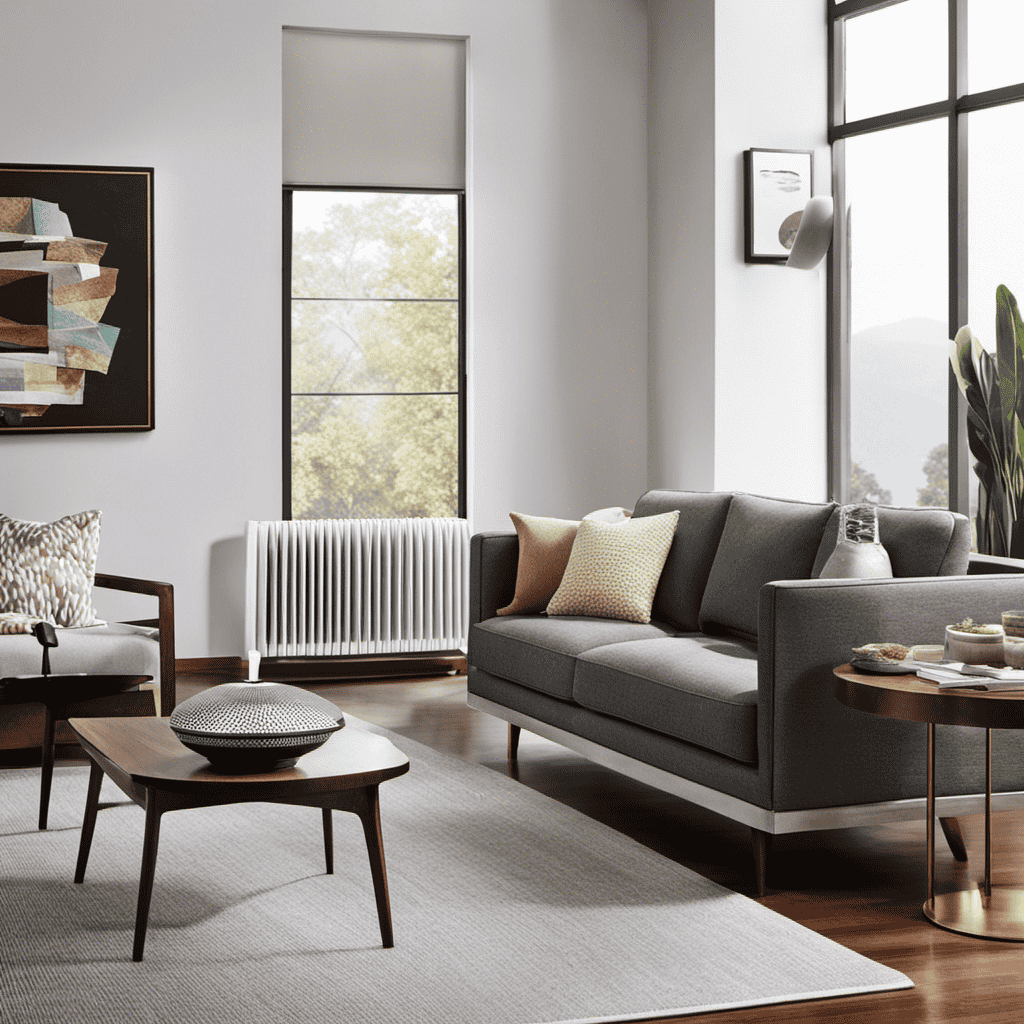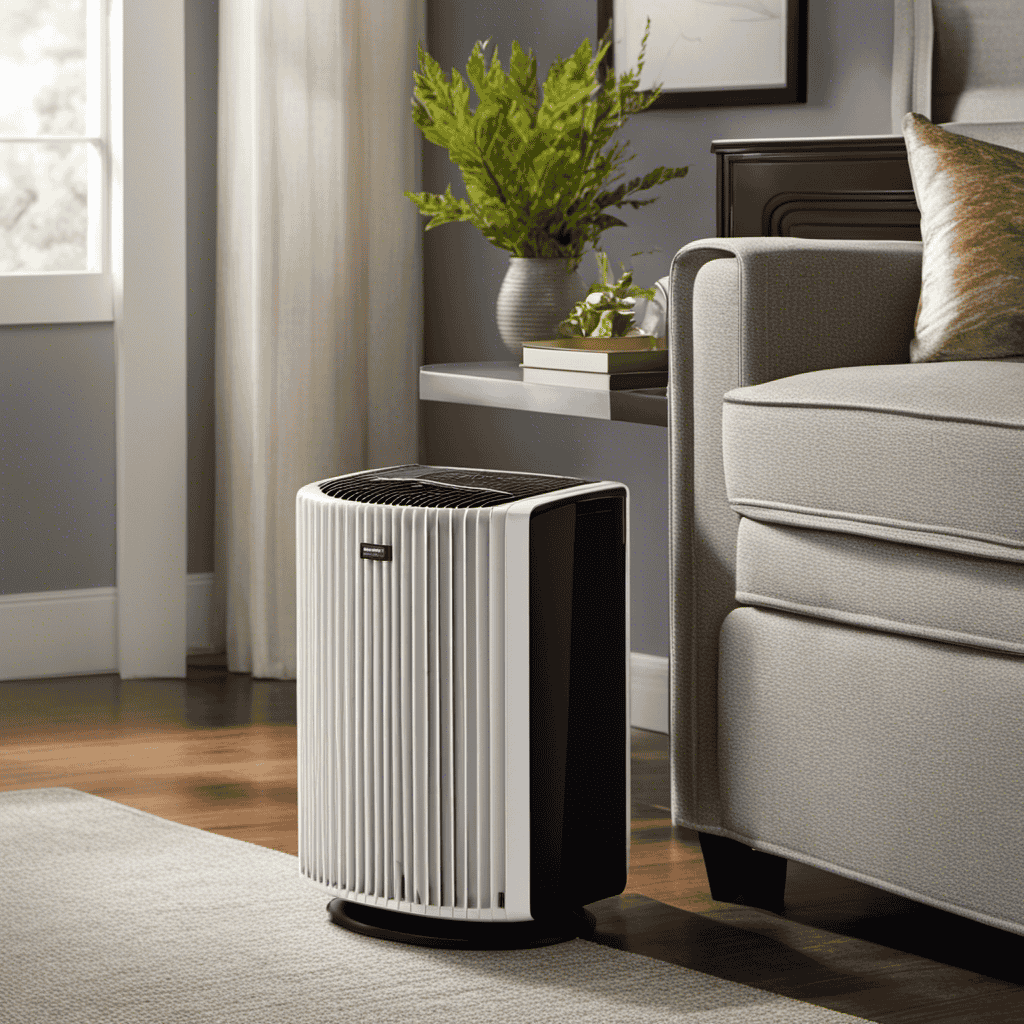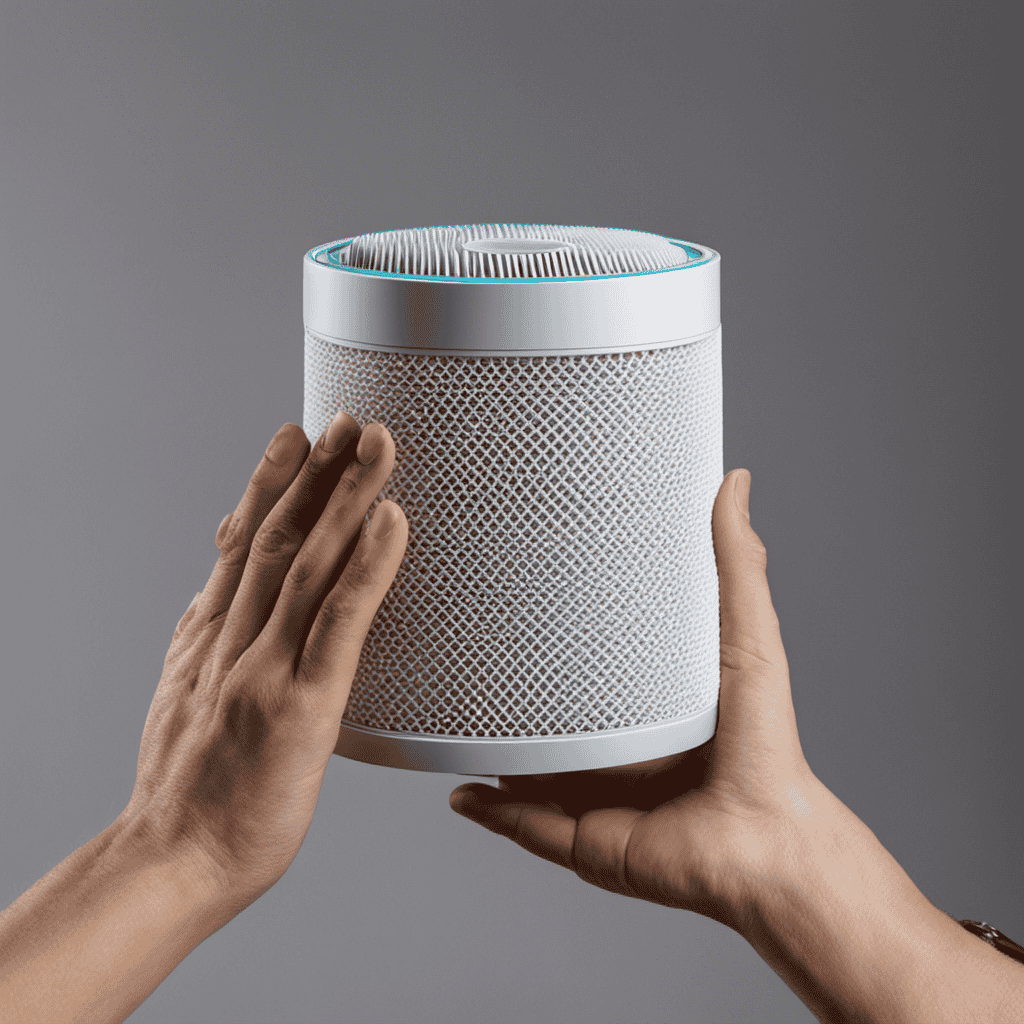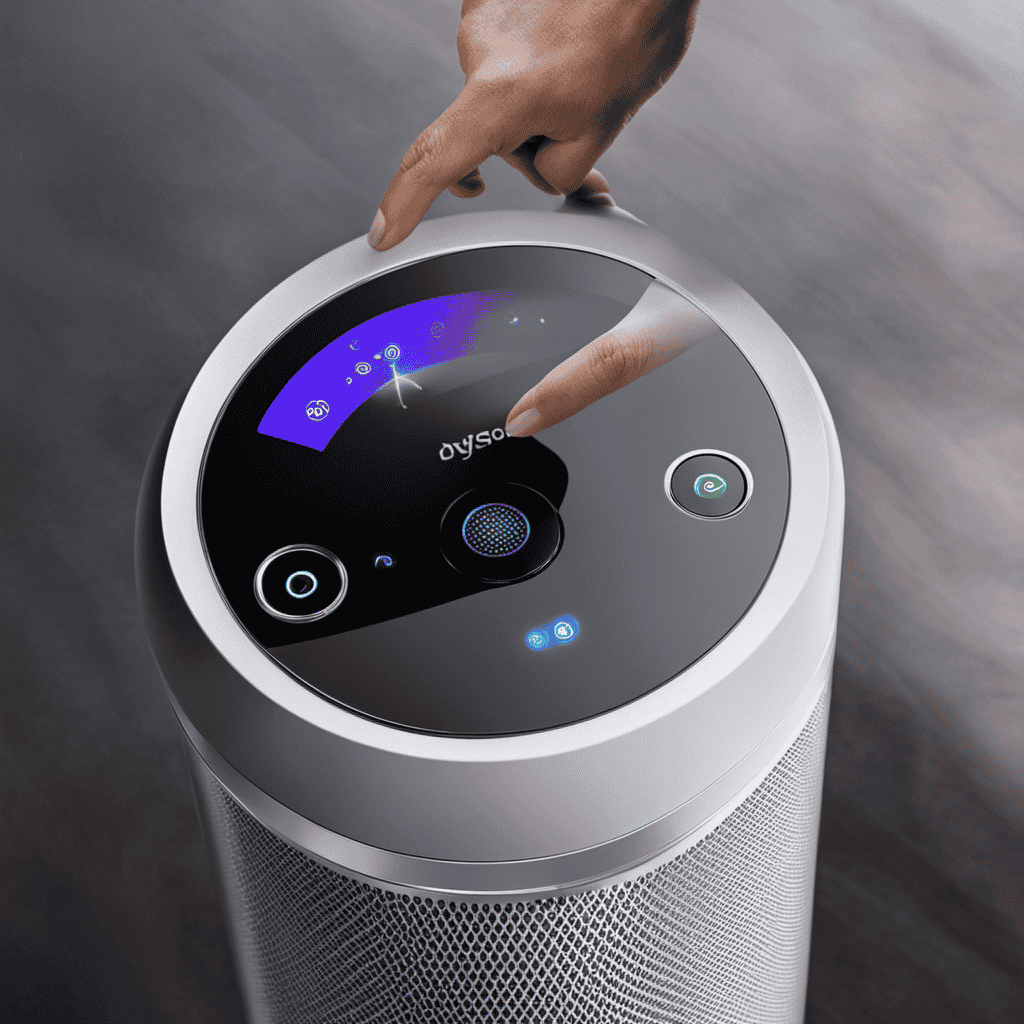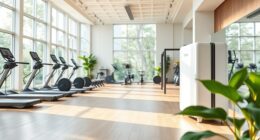Hello there!
Ever wondered how a room air purifier works? Well, I’ve got all the details for you.
In this article, we’ll delve into the fascinating world of air purification and explore the different technologies that make it possible. From HEPA filters to UV-C light, we’ll uncover the secrets behind clean and fresh air.
So, if you’re ready to breathe easier and improve your indoor air quality, let’s dive right in!
Key Takeaways
- Different types of filters, such as pre-filter, activated carbon filter, and HEPA filter, work together to capture and remove different types of pollutants from the air.
- Proper positioning of the air purifier and regular maintenance are important for effective air circulation and improved indoor air quality.
- HEPA technology is highly efficient in capturing tiny particles and improving indoor air quality.
- Activated carbon filtration is effective in eliminating odors, gases, and chemicals from the air.
Filter Types
There are three main filter types used in room air purifiers. These filters are essential for capturing and removing airborne particles, allergens, and pollutants from the air we breathe.
The first filter type is the pre-filter. It traps larger particles like dust and pet hair, preventing them from entering the main filter.
The second filter type is the activated carbon filter, which absorbs odors, gases, and chemicals. This filter is particularly beneficial for people with sensitivities or allergies.
Lastly, the HEPA filter is the most important one. It captures tiny particles as small as 0.3 microns, including pollen, mold spores, and bacteria.
To ensure optimal performance, regular air purifier maintenance is necessary. This includes replacing filters according to the manufacturer’s instructions, cleaning the unit regularly, and monitoring air quality for any signs of degradation.
Air Circulation
To circulate the clean air effectively, you’ll want to position the purifier in a central location within the room. This allows the air purifier to evenly distribute purified air throughout the entire space.
Here are three key benefits of proper air circulation:
-
Improved Indoor Air Quality: By placing the air purifier in a central location, it can effectively capture and remove pollutants from all areas of the room. This leads to cleaner and healthier air for you and your family to breathe.
-
Reduced Allergens and Asthma Triggers: Proper air circulation helps remove common allergens such as dust, pollen, and pet dander. This can provide relief for those suffering from allergies or asthma.
-
Odor Elimination: With the purifier positioned centrally, it can effectively remove unpleasant odors from all corners of the room. This is especially beneficial for kitchens, bathrooms, and rooms with pets.
To further enhance air circulation, ensure that the purifier has features such as multiple air intake vents and adjustable fan speeds. These features help optimize the airflow and increase the purifier’s effectiveness in circulating clean air throughout the room.
HEPA Technology
When it comes to air purification, understanding the filter efficiency levels is crucial. HEPA technology, known for its high efficiency, can capture up to 99.97% of airborne particles as small as 0.3 microns.
This level of filtration is important for improving indoor air quality and reducing the presence of allergens, dust, and other contaminants in the environment.
Filter Efficiency Levels
Filter efficiency levels can vary depending on the type of air purifier you choose. To ensure air purifier effectiveness and proper filter maintenance, it is important to understand the different filter efficiency levels available.
Here are three common filter types and their respective efficiency levels:
-
HEPA filters: These filters are highly effective in removing airborne particles as small as 0.3 microns, capturing up to 99.97% of pollutants.
-
Activated carbon filters: These filters are excellent at removing odors, gases, and volatile organic compounds (VOCs) from the air. They are less effective at capturing larger particles like dust and pollen.
-
Pre-filters: These filters are the first line of defense and capture larger particles like dust and pet hair. While they may not have high efficiency levels, they help extend the lifespan of the main filter.
Regular filter maintenance is crucial to maintain air purifier effectiveness. It is recommended to replace or clean filters according to the manufacturer’s instructions to ensure optimal performance.
Airborne Particle Removal
Understanding the efficiency levels of different filter types will help you choose the best air purifier for removing airborne particles. When considering an air purifier, it is important to take into account the size of the room you will be using it in and the noise level it produces. A larger room may require a more powerful air purifier to effectively clean the air, while a smaller room may be adequately serviced by a smaller unit. Additionally, noise level is a crucial factor to consider, especially if you plan on using the air purifier in a bedroom or office space where silence is desired. By considering these factors, you can select an air purifier that meets your specific needs.
| Filter Type | Efficiency Level | Features |
|---|---|---|
| HEPA Filter | 99.97% | Effective against dust, pollen, pet dander |
| Activated Carbon Filter | 99% | Removes odors, gases, and volatile organic compounds |
| UV-C Light Filter | 99% | Kills bacteria and viruses |
Table: Comparison of Air Purifier Filter Types.
Indoor Air Quality
To improve indoor air quality, it’s important to regularly clean and maintain your air purifier. Here are three reasons why:
-
Efficient Filtration: Air purifiers trap and remove airborne particles, such as dust, pollen, and pet dander. This helps reduce allergens and respiratory irritants in the air.
-
Eliminates Odors: Some air purifiers are equipped with activated carbon filters that absorb and neutralize unpleasant odors from cooking, pets, or smoke. This not only improves the smell of the air but also enhances the overall indoor environment.
-
Health Benefits: Poor indoor air quality can have detrimental effects on your health, causing symptoms like coughing, sneezing, and headaches. By using an air purifier, you can reduce exposure to pollutants and improve your respiratory health.
Regular maintenance of your air purifier, including cleaning or replacing filters and ensuring proper ventilation systems, is crucial for its optimal performance.
Now, let’s dive into the next section about activated carbon filters.
Activated Carbon Filters
When it comes to odor elimination and chemical pollutant absorption, activated carbon filters are a reliable solution.
These filters are designed to effectively capture and remove unpleasant odors, such as those from pets, cooking, and smoke.
Additionally, they have the ability to trap and neutralize harmful chemicals and volatile organic compounds (VOCs) present in the air, improving the overall indoor air quality.
Odor Elimination With Carbon
The room air purifier works by using carbon to eliminate odors. This is achieved through the process of activated carbon filtration, which effectively traps and removes odor-causing molecules from the air.
Here’s how it works:
-
Adsorption: The activated carbon in the air purifier has a large surface area with countless microscopic pores. When air passes through the purifier, the carbon attracts and holds onto odor molecules, effectively adsorbing them.
-
Chemical reaction: The activated carbon undergoes a chemical reaction with the odorous compounds in the air, breaking them down into simpler, odorless molecules.
-
Long-lasting effectiveness: The activated carbon in the purifier is designed to have a high capacity for adsorption and a long lifespan. This ensures that the purifier can continue effectively eliminating odors for an extended period of time.
With its activated carbon filtration technology, the room air purifier provides efficient and reliable odor control, making your living space fresh and pleasant.
Chemical Pollutant Absorption
You can rely on the activated carbon filtration in the room air purifier to effectively absorb chemical pollutants, ensuring cleaner and healthier air in your living space. The chemical reaction that takes place in this process occurs when the chemical pollutants come into contact with the activated carbon. The activated carbon has a large surface area with numerous tiny pores that trap and hold the chemical pollutants through a process called adsorption. This means that the chemical pollutants stick to the surface of the activated carbon, removing them from the air. The table below provides a visual representation of how the air purification process works with activated carbon filtration.
| Step | Process |
|---|---|
| 1 | Air is drawn into the purifier |
| 2 | Air passes through the activated carbon filter |
| 3 | Chemical pollutants are trapped and held by the activated carbon |
| 4 | Clean air is released back into the room |
| 5 | Repeat process continuously for ongoing air purification |
With the activated carbon filtration effectively absorbing chemical pollutants, the subsequent section will discuss the process of ionization.
Ionization
Ionization helps remove harmful particles from the air by charging them and causing them to stick to surfaces. Negative ions are generated by the air purifier and released into the air. These negative ions attach to airborne particles, such as dust, allergens, and pollutants, giving them an electrostatic charge. This charge makes the particles heavier and causes them to be attracted to surfaces in the room.
Here’s how it works:
- Negative ions are produced by the air purifier.
- These ions attach to airborne particles in the air.
- The charged particles are attracted to surfaces like walls or furniture and are no longer floating in the air.
UV-C Light
UV-C light helps kill bacteria, viruses, and other microorganisms in the air. It does this by damaging their DNA and preventing them from reproducing. When emitted by a room air purifier, UV-C light penetrates the cells of these microorganisms and causes irreversible damage to their genetic material. This disrupts their ability to function and reproduce, ultimately leading to their destruction.
UV-C light is particularly effective against airborne pathogens. It can reach areas that may be difficult to clean or disinfect through other methods. By incorporating UV-C light into air purification systems, it provides an additional layer of protection against harmful microorganisms in indoor environments.
This technology, along with ionization, helps create cleaner and safer air by eliminating these invisible threats.
Maintenance and Cleaning
To ensure optimal performance, it’s important to regularly clean and maintain your air purification system. Here are some maintenance tips and a troubleshooting guide to help you keep your system in top shape:
-
Clean or replace the filters: The filters in your air purifier trap dust, allergens, and other particles. Regularly clean or replace them according to the manufacturer’s instructions.
-
Check for blockages: Make sure there are no blockages in the air intake or exhaust vents. Blocked vents can reduce the efficiency of the system.
-
Clean the exterior: Dust and dirt can accumulate on the exterior of the air purifier, affecting its performance. Wipe it down regularly with a damp cloth.
Troubleshooting guide:
-
If the air purifier is not turning on, check the power supply and make sure it is properly plugged in.
-
If the unit is emitting strange odors, it may be time to clean or replace the filters.
-
If the air purifier is making excessive noise, check for loose or damaged parts and tighten or replace them as necessary.
Following these maintenance tips and troubleshooting guide will help ensure that your air purification system works efficiently and effectively.
Frequently Asked Questions
How Often Should I Replace the Filters in My Room Air Purifier?
I replace the filters in my room air purifier every 3-6 months. Regular filter replacement ensures optimal performance and efficiency, as it removes dust, allergens, and other particles from the air, promoting cleaner and healthier indoor air quality.
Can an Air Purifier Remove All Types of Odors From My Room?
Yes, an air purifier can remove most types of odors from your room. Some models use filters to capture particles and neutralize odors, while others use activated carbon to absorb odorous molecules.
Is It Safe to Leave the Air Purifier Running All Night While I’m Asleep?
Yes, it is safe to leave the air purifier running all night. While some may worry about the noise, the benefits of running an air purifier at night, such as improved air quality and better sleep, outweigh any minor inconvenience.
Are There Any Side Effects of Using an Ionization Air Purifier?
Yes, there can be potential risks and long-term effects associated with using an ionization air purifier. It’s important to research and understand the specific model you’re using to minimize any potential negative impacts on your health.
Can a Room Air Purifier Help Reduce the Symptoms of Allergies or Asthma?
Yes, a room air purifier can help reduce the symptoms of allergies or asthma. I have personally experienced the effectiveness and benefits of using an air purifier in my home.
What Makes Dyson Air Purifiers Different from Regular Room Air Purifiers?
Dyson air purifier functionality sets it apart from regular room air purifiers. With advanced features like 360-degree filtration, automatic sensing, and air projection, Dyson purifiers effectively capture pollutants and circulate purified air throughout the room. Its innovative design and cutting-edge technology make it a standout choice for clean indoor air.
Conclusion
Well, who would have thought that something as simple and compact as a room air purifier could work wonders in cleaning the air we breathe?
With its various filter types, air circulation system, HEPA technology, activated carbon filters, ionization, and UV-C light, this little machine is a force to be reckoned with.
And let’s not forget about the maintenance and cleaning it requires, because even the best air purifiers need a little TLC.
So next time you take a deep breath of fresh, clean air, thank your trusty room air purifier for making it possible.
